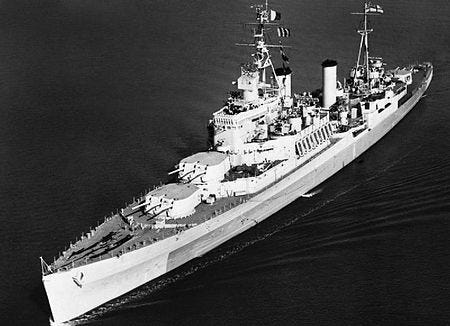HMCS UGANDA (later QUEBEC) joined the British Pacific Fleet (BPF) on April 8th, 1945, having sailed from Alexandria in February. For the next three months she was an integral piece of the BPF, which was commanded by Admiral Sir Bruce Fraser. The seagoing Task Force was under the command of Vice-Admiral Bernard Rawlings.
UGANDA made good use of her heavy guns to pound enemy positions. For an attack on Truk, she hurled 12 tons of explosives at the Japanese.
Besides her heavy armament of six- and four-inch guns, she bristled with anti-aircraft weapons of 40 and 20 mm that were put to use against Japanese kamikaze fighters. It seems that British aircraft carriers were poorly armed against aircraft, and cruisers like UGANDA made major contributions to their defence.
Until she was replaced by an arriving RN cruiser on July 27th, HMCS UGANDA gave a good account of herself. The RCN and RCNVR men aboard could hold their collective heads up.
But half a world away, in Ottawa, events conspired against the ship and her crew.
In early April 1945 Prime Minister Mackenzie King, preparing for a statement to parliament, worried about an upcoming general election. He wanted men and women serving overseas against Germany and Japan to vote Liberal, stating “there will be a big swing toward ourselves on the part of our troops now serving abroad;” and, “…[our marvelous record as a government would make sure] that the men who have fought would have the chance to decide to cast their votes under most favourable conditions…”
On April 18th, naval headquarters signalled UGANDA that “only volunteers will be sent to the Far East”--this to a ship already at war in the Far East. And of course they were already volunteers for the war in general. As a result of the signal Captain Mainguy, UGANDA’s Commanding Officer, announced to the ship’s company on May 6th that a vote would be held during which the men who did not wish to continue the fight against Japan could sign a form in his secretary’s office certifying “I do not volunteer for service in the war against Japan…”
The vote did not go the way Mainguy hoped.
June 2nd, 1945, was a big day for the crew. They got to vote in the Canadian general election, and also to vote officially on the question of continuing to volunteer for the war against Japan or not.
Two things happened: the Liberal government was re-elected, and UGANDA’s ship’s company voted 556 to 334 to NOT volunteer.
UGANDA was in an impossible position. The government decreed that men not volunteering to continue the fight against Japan were to be replaced immediately with those who did volunteer. And where were those replacements available? Back in Canada, of course. And in an arrangement that guaranteed a Catch-22-like position, those who volunteered were eligible for immediate leave. All this guaranteed that when UGANDA left the battle against the Japanese, she would be absent for months.
The Royal Navy said all the right things. in the words of Admiral Fraser, “(All this) caused a fine ship to be withdrawn from the line for other than operational reasons.”
While UGANDA transitted home, the Enola Gay dropped Little Boy over Hiroshima on August 6th and the war was effectively over soon after.
On August 10th, HMCS UGANDA arrived in Esquimalt. She had fired her last shot in anger.
For new subscribers, you can review prior “Forces with History” on my website, www.robertwmackay, ca. Thanks for joining, and welcome aboard!





The fact that Uganda was on her way home when the bomb was dropped on Hiroshima does take away some of negative reaction to the decision by the ship's company. I seem to recall that Uganda was not well received when she made a call in Hawaii.